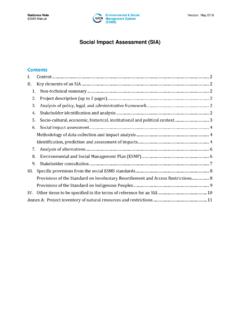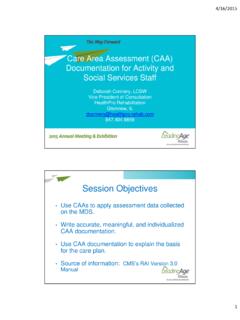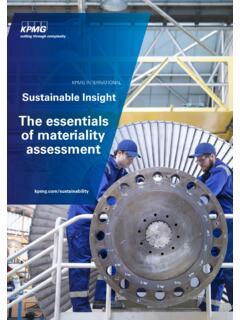Transcription of ASSESSMENT SOCIAL ANXIETY (SOCIAL PHOBIA) The …
1 6 The Complete PractitionerOctober 1999 ASSESSMENTSOCIAL ANXIETY ( SOCIAL PHOBIA) The Liebowitz SOCIAL ANXIETY Scale1 (LSAS) assesses the range of ANXIETY /fear and avoidance present in patientswhen confronted with situations requiring SOCIAL interaction or performance. Based on data from several outpatienttreatment studies, this ASSESSMENT screening instrument appears to be reliable and valid, both for initial assess-ments of SOCIAL ANXIETY (also known as SOCIAL phobia) and for followup assessments to help determine response Although originally designed as a clinician-rated scale, the version presented here may be administeredas either a self-report scale or as a clinician-rated for Administering the LSASAsk the patient to rate ANXIETY /fear and avoidance levels for the items listed (based on experiences during the pastweek).
2 If the patient has not experienced a situation described in an item, ask the patient to decide on the ratings byimagining how he or she would have responded had the situation actually occurred. Each item is rated from 0 to 3 asdefined on the questionnaire (next page). Emphasize the importance of consistency in rating each item the same wayeach time through the scale. For example, for Item 20, if the patient based the initial ratings on giving an oral report toa small group of coworkers, when the patient completes this scale on subsequent administrations, the ratings shouldalso be based on giving an oral report to a small group of coworkers. When administered as a clinician-rated scale, theclinician is given latitude to question the patient s responses and adjust the ratings accordingly.
3 Instructions for Scoring the LSAS An overall, or global, score may be calculated by summing the total fear/ ANXIETY and total avoidance scores, andis interpreted as follows:50-69 Moderate SOCIAL ANXIETY disorder70-89 Marked SOCIAL ANXIETY disorder90-109 Severe SOCIAL ANXIETY disorder110 or greaterVery severe SOCIAL ANXIETY disorder A performance score may be calculated by summing the total fear/ ANXIETY and total avoidance scores for theperformance items (1, 2, 3, 4, 6, 8, 9, 13, 14, 16, 17, 20, 21). A SOCIAL interaction score may be calculated by summing the total fear/ ANXIETY and total avoidance scores forthe SOCIAL interaction items (5, 7, 10, 11, 12, 15, 18, 19, 22, 23, 24). Four separate scores for performance fear/ ANXIETY , performance avoidance, SOCIAL interaction fear/ ANXIETY ,and SOCIAL interaction avoidance may be obtained in the same manner as obtaining the performance and socialinteraction scores, except that the fear/ ANXIETY and avoidance totals do not get MR.
4 SOCIAL phobia. Modern Problems in Pharmacopsychiatry, 22:141-173, RG, Horner KJ, Juster HR, Safren ES, Brown AJ, Schneier FR, & Liebowitz MR. Psychometric properties of the Liebowitz SocialAnxiety Scale. Psychological Medicine, 29:199-212, 1999. The Complete Practitioner would like to thank the author of the LSAS, Dr. Michael Liebowitz, for reviewing this presentation of the LSASand for providing updated scoring ranges. [updated scoring ranges]7 The Complete PractitionerOctober 1999 ASSESSMENTSOCIAL ANXIETY ( SOCIAL PHOBIA) LIEBOWITZ SOCIAL ANXIETY SCALE (Self-Report Version)1,2 Name _____ Date _____Fill out the following questionnaire with the most suitable answer listed below. Base your answers on your experiencein the past week and, if you have completed the scale previously, be as consistent as possible in your perception ofthe situation described.
5 Be sure to answer all ORANXIETY AVOIDANCE1. Telephoning in public - speaking on the telephone in a public place2. Participating in small groups - having a discussion with a few others3. Eating in public places - do you tremble or feel awkward handling food4. Drinking with others in public places - refers to any beverage including alcohol5. Talking to people in authority - for example, a boss or teacher6. Acting, performing or giving a talk in front of an audience - refers to a large audience7. Going to a party -an average party to which you may be invited; assume you know some butnot all people at the party8. Working while being observed - any type of work you might do including school work orhousework9. Writing while being observed - for example, signing a check in a bank10.
6 Calling someone you don t know very well11. Talking with people you don t know very well12. Meeting strangers - assume others are of average importance to you13. Urinating in a public bathroom - assume that others are sometimes present, as might normallybe expected14. Entering a room when others are already seated - refers to a small group, and nobodyhas to move seats for you15. Being the center of attention - telling a story to a group of people16. Speaking up at a meeting - speaking from your seat in a small meeting or standing up in placein a large meeting17. Taking a written test18. Expressing appropriate disagreement or disapproval to people you don t know very well19. Looking at people you don t know very well in the eyes - refers to appropriate eyecontact20.
7 Giving a report to a group - refers to an oral report to a small group21. Trying to pick up someone - refers to a single person attempting to initiate a relationship witha stranger22. Returning goods to a store where returns are normally accepted23. Giving an average party24. Resisting a high pressure salesperson - avoidance refers to listening to the salespersonfor too longFear or AnxietyAvoidance0 = None0 =Never (0%)1 = Mild1 =Occasionally (1%-33% of the time)2 = Moderate2 =Often (33%-67% of the time)3 = Severe3 =Usually (67%-100% of the time)Understanding the situations:1 The LSAS self-report version may also be used as a clinician-rated LSAS self-report version is available from SmithKline Beecham Pharmaceuticals. A pad of several copies can be obtained by faxinga request on your professional letterhead for Item #PX0196 (215-751-4142).








